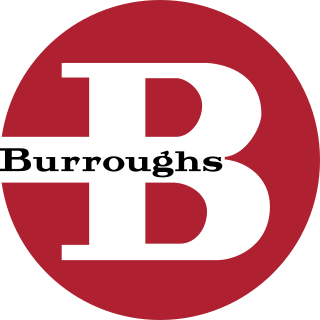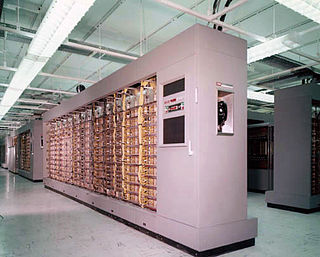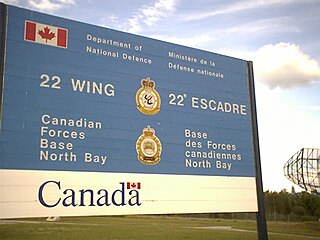Related Research Articles

The Burroughs Corporation was a major American manufacturer of business equipment. The company was founded in 1886 as the American Arithmometer Company. In 1986, it merged with Sperry UNIVAC to form Unisys. The company's history paralleled many of the major developments in computing. At its start, it produced mechanical adding machines, and later moved into programmable ledgers and then computers. It was one of the largest producers of mainframe computers in the world, also producing related equipment including typewriters and printers.

A mainframe computer, informally called a mainframe or big iron, is a computer used primarily by large organizations for critical applications like bulk data processing for tasks such as censuses, industry and consumer statistics, enterprise resource planning, and large-scale transaction processing. A mainframe computer is large but not as large as a supercomputer and has more processing power than some other classes of computers, such as minicomputers, servers, workstations, and personal computers. Most large-scale computer-system architectures were established in the 1960s, but they continue to evolve. Mainframe computers are often used as servers.

The Semi-Automatic Ground Environment (SAGE) was a system of large computers and associated networking equipment that coordinated data from many radar sites and processed it to produce a single unified image of the airspace over a wide area. SAGE directed and controlled the NORAD response to a possible Soviet air attack, operating in this role from the late 1950s into the 1980s. Its enormous computers and huge displays remain a part of cold war lore, and after decommissioning were common props in movies such as Dr. Strangelove and Colossus, and on science fiction TV series such as The Time Tunnel.

John Adam Presper Eckert Jr. was an American electrical engineer and computer pioneer. With John Mauchly, he designed the first general-purpose electronic digital computer (ENIAC), presented the first course in computing topics, founded the Eckert–Mauchly Computer Corporation, and designed the first commercial computer in the U.S., the UNIVAC, which incorporated Eckert's invention of the mercury delay-line memory.

Sperry Corporation was a major American equipment and electronics company whose existence spanned more than seven decades of the 20th century. Sperry ceased to exist in 1986 following a prolonged hostile takeover bid engineered by Burroughs Corporation, which merged the combined operation under the new name Unisys. Some of Sperry's former divisions became part of Honeywell, Lockheed Martin, Raytheon Technologies, and Northrop Grumman.

UNIVAC was a line of electronic digital stored-program computers starting with the products of the Eckert–Mauchly Computer Corporation. Later the name was applied to a division of the Remington Rand company and successor organizations.
JOVIAL is a high-level programming language based on ALGOL 58, specialized for developing embedded systems. It was a major system programming language through the 1960s and 1970s.
The Information Processing Techniques Office (IPTO), originally "Command and Control Research", was part of the Defense Advanced Research Projects Agency of the United States Department of Defense.
Loral Corporation was a defense contractor founded in 1948 in New York by William Lorenz and Leon Alpert as Loral Electronics Corporation. The company's name was taken from the first letters of each founder's surname.

The AN/FSQ-7 Combat Direction Central, referred to as the Q7 for short, was a computerized command and control system for Cold War ground-controlled interception used in the USAF Semi-Automatic Ground Environment (SAGE) air defense network.
A penetration test, colloquially known as a pentest or ethical hacking, is an authorized simulated cyberattack on a computer system, performed to evaluate the security of the system; this is not to be confused with a vulnerability assessment. The test is performed to identify weaknesses, including the potential for unauthorized parties to gain access to the system's features and data, as well as strengths, enabling a full risk assessment to be completed.
Keith Uncapher (1922–2002) was an American computer engineer and manager. At the RAND Corporation Uncapher worked on several pioneering computer projects. He founded the Information Sciences Institute (ISI) at the University of Southern California, Viterbi School of Engineering. There, he assembled teams of engineers who helped to grow the early Internet.
The IBM AN/FSQ-31 SAC Data Processing System was a USAF command, control, and coordination system for the Cold War Strategic Air Command (SAC). IBM's Federal Systems Division was the prime contractor for the AN/FSQ-31s, which were part of the TBD 465L SAC Automated Command and Control System (SACCS), a "Big L" system of systems (cf. 416L SAGE & 474L BMEWS( which had numerous sites throughout the Continental United States: "all SAC command posts and missile LCC's", a communication network, etc.; and the several FSQ-31 sites including:

The AN/FSQ-32 SAGE Solid State Computer was a planned military computer central for deployment to Super Combat Centers in nuclear bunkers and to some above-ground military installations. In 1958, Air Defense Command planned to acquire 13 Q-32 centrals for several Air Divisions/Sectors.
OS 2200 is the operating system for the Unisys ClearPath Dorado family of mainframe systems. The operating system kernel of OS 2200 is a lineal descendant of Exec 8 for the UNIVAC 1108. Documentation and other information on current and past Unisys systems can be found on the Unisys public support website.
The Burroughs AN/GSA-51 Radar Course Directing Group was a United States Air Force air defense command, control, and coordination system, part of the Semi-Automatic Ground Environment system. It was intended to replace vacuum tube IBM AN/FSQ-7 Combat Direction Centrals. Developed under Electronic Systems Division's 416M Program, in 1962 Burroughs "won the contract to provide a military version of its D825" modular data processing system for the AN/GSA-51 to be used at "BUIC II radar sites" BUIC II was 1st used at North Truro Z-10 in 1966, and the Hamilton AFB BUIC II was installed in the former MCC building.

A Super Combat Center (SCC) was a planned Cold War command and control facility for ten NORAD regions/Air Divisions in Canada and the United States. For installation in nuclear bunkers, the command posts were to replace the last of the planned Air Defense Command Combat Centers to be built for vacuum tube AN/FSQ-8 Combat Control Centrals. The survivable SCCs were to use solid-state (transistorized) AN/FSQ-32 equipment which was to provide the Semi-Automatic Ground Environment for operators at 10 Air Divisions — 5 of the centers were to also serve as Air Defense Direction Centers ("SCC/DCs") for commanding ground-controlled interception in sectors of the 27th, 30th, 32nd, 33rd, and 35th Air Divisions. ADC's November 1958 plan to complete the hardened SCCs by April 1964 included fielding 3 additional AN/FSQ-32 systems above-ground for the Albuquerque, Miami, and Shreveport sectors.

The ITT 465L Strategic Air Command Control System was a Cold War "Big L" network of computer and communication systems for command and control of Strategic Air Command "combat aircraft, refueling tankers, [and] ballistic missiles". International Telephone and Telegraph was the prime contractor for Project 465, and SACCS had "Cross Tell Links" between command posts at Offutt AFB, March AFB, & Barksdale AFB (SACCS also communicated with the Cheyenne Mountain Complex and Air Force command posts. The 465L System included IBM AN/FSQ-31 SAC Data Processing Systems, Remote and Simplex Remote Communication Systems, SAC Network Control Office, "4-wire, Schedule 4, Type 4B alternate voice-data operation", and one-way communication with "ICBM launch control centers" In addition to IBM for the "Super SAGE type computers", another of the 6 direct subcontractors was AT&T,
Jules I. Schwartz was an American computer scientist chiefly known for his creation of the JOVIAL programming language.
Marlene Hazle was an American known for her work in computer science throughout the 20th century. She worked at RAND Corporation and Mitre Corporation for development of the Semi-Automatic Ground Environment and AESOP respectively. Hazle eventually became a supervisor and trained military personnel on the SAGE operating system. Hazle continued making contributions to the fields of computer science and aerospace throughout the 20th century.
References
- ↑ See Campbell-Kelly, 2003, pp.36-41.
- ↑ See Buderi, 1998, p.396.
- ↑ Defense & Security Intelligence & Analysis: IHS Jane's | IHS Archived 2012-05-09 at the Wayback Machine . Articles.janes.com. Retrieved on 2014-02-21.
- ↑ Franks, E.W. (1966). "A Data Management System for Time-Shared File Processing Using a Cross-Index File and Self-Defining Entries" (PDF). IEEE Computer Society Proceedings-Spring Joint Computer Conference, 1966. Archived from the original (PDF) on 2018-07-27. Retrieved 2018-07-27.
- Claude Baum, The System Builders: The Story of SDC, System Development Corp., Santa Monica, CA, 1981. ISBN 0-916368-02-5.
- Robert Buderi, The Invention that Changed the World: How a small group of radar pioneers won the Second World War and launched a technological revolution. Touchstone, New York, NY, 1998. ISBN 0-684-83529-0
- Martin Campbell-Kelly, From Airline Reservations to Sonic the Hedgehog. A History of the Software Industry. MIT Press, Cambridge, MA, 2003. ISBN 0-262-03303-8.